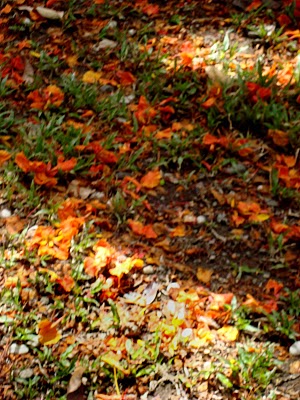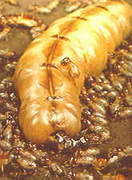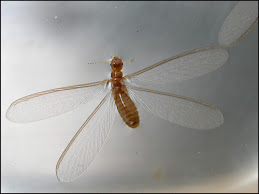
A hill of Dragon Fruit intercropped with coffee in Amadeo,
Cavite. This photo was taken during its non-fruiting season
in February 2010.
The color is bright pinkish red, this secret fruit of the Vietnamese that my wife brought home from that war torn country. It is large, it could weigh a kilogram and the price is equivalent to P100. The fruit is characterized by the presence of prominent calyxes arranged like the eyes of Irish potato. It resembles no other kind of fruit in the local market.
The skin is tight and leathery, and to peel it one must cut the fruit first into two or four. There is the white fleshy mass studded all over with countless tiny black seeds, and there is no way to eat it without eating the seeds, too. The taste is delicious, slightly sweet, refreshing, with fine texture and firmness of a ripe guava, sans its aroma.
My younger son, Leo Carlo, took some of the seeds and planted them. At that time I had no inkling that Dragon Fruit is a fruit of a cactus. Who would suspect it upon seeing the first pair of leaves? It is a dicot, all right, but to be a cactus species is remote.
After germination the characteristic cactus character soon emerges, spines begin to form at intervals on the a long unbranched proto-trunk. Unmistakably the seedling is a miniature of prickly pear cactus.
It was in Mexico where I first tasted cactus fruit, specifically in Texcoco, one hour ride from Mexico City, the site of the International Wheat and Corn Improvement Research Center (CIMMYT), the counterpart of our IRRI. I spent a season in the institute then working on tropical wheat, but I also had time to study other things.
The cactus pear Opuntia is popular in Mexico. It is known as nopalito. It is cooked or roasted after removing the spines, and is served as salad or cooked dish. It is also used as cattle feed, indeed an excellent supplement owing to the cactus’ high water content, and to the scarcity of other fresh feeds in this semi-arid region.
Opuntia has become a major source of animal feeds in Brazil, US, Peru, South Africa, Tunisia, and Italy. In Israel Opuntia is a promising crop for the arid and semi-arid areas. With the declining amount and high cost of water supply the thrust of agriculture is to find resistant but profitable crops for these marginal areas and wastelands. When I was attending a conference-workshop at the Afro-Asian Institute I saw Opuntia cultivated on an experimental farm near Ben-Gurion University. But it is for its medicinal value in alleviating symptoms of prostate cancer, I was told, an old Sicilian remedy that the Israelis are researching on. Today Prostacal a preparation from Opuntia extract is marketed worldwide by an international pharmaceutical company.
There is another edible cactus I found. It is as tall as an average person, its fruit half the size of a closed fist, and bright yellow to red when ripe, and the trees in season, break the otherwise dull and prosaic surrounding of the arid landscape. Much of Mexico is desert and it is here in the deserted Aztec city, Teotihuacan, where I found the plant which has these characteristics.
The stout trunk is cylindrical, bearing fleshy, flattened ascending jointed branches. The joints are green, 10 to 25 cm long, widest near the tip and narrowed at the base with cushion-like areoles that bear numerous spines or glocids in group. This description fits with that of the Philippine dilang-baka, Nopalea cochinellifera (L) Salm-Dyck which bears berries 5 cm long, pear-shaped fleshy, many-seeded, red, and is known to be edible. I suspect that the dilang baka cactus is the same species as the edible Mexican cactus that the Aztecs used. Probably it was introduced by the Spaniards into the Philippines among other plants from Mexico during the Spanish era, such as avocado, the national fruit of Mexico, kalachuche or frangipani, and acacia (Samanea saman). Dilang baka is known today only as an ornamental rather that an orchard plant.
There is also another cactus indigenous to Mexico, peyote (Lophophora Williamsii) that is the source of mescal button. It grows on the arid plateaus as far as Southwestern United States. This cactus has no spines, and the whole plant resembles a huge carrot, except for its button-studded top. Mescal buttons have strong narcotic properties that the native Indians use in ceremonies and rituals. Definitely Dragon Fruit is a far relative of this cactus.
In my research I also came across the problem of Prickly Pear (Opuntia inermis) which was introduced in Australia several years ago as an ornamental. It soon became wild and turned as pest invading pasture and farms. To control it, an insect (Cactoblastis cactorum) was introduced as a biological agent that slowly but progressively destroyed the plants hill after hill until whole fields were rid of this spiny cactus.
Going back to the Dragon Fruit, I consulted Dr. Domingo Tapiador, an FAO expert, and he showed me a picture of a pear cactus. It is similar to the Mexican Opuntia, and he is recommending it for the marginal areas. Showing him the familiar picture of the Dragon Fruit, he told me it can also thrive on arid wasteland as shown by Israel's experience.
Present research has succeeded in acclimatizing Dragon Fruit in the country. I saw hills of Dragon fruit in Amadeo, Cavite. Unfortunately it was off season and the plants did not have fruits. Locally grown dragon fruits sold in supermarkets are smaller than the imported ones. My research led me in meeting some friends from Israel which have lately started to export Dragon Fruit. It means that this forest plant has been successfully acclimatized as a desert crop, indeed an extreme adaptive transformation.
Dragon fruit, also known as Eden Fruit, was developed from a group of epiphytic cacti native to the forests of Mexico, and the rainforest of northern South America and Southeast Asia. Having an epiphytic habit and lacking soil roots, the plant obtains water and nutrients from falling organic debris caught by its tangled aerial roots. Thus it earned its name, Crawling Pitaya. Scientifically it isHylocereus undatus. Researchers found out that it requires one-tenth the water requirement of any known domesticated crop, and this is what makes it suitable as drought- resistant plant. But it took years and countless experiments to domesticate it. In Israel alone, some 1000 hybrids were developed from the wild species, and prospects of high yield and better tasting fruits are vigorously being pursued. Israel is now exporting dragon fruit.
Thanks to the unknown scientist (or native) who brought down Dragon Fruit from the wild. Thanks to the Vietnamese farmer who first commercialize its cultivation. To the Israelis who have found a new place for Dragon Fruit in the desert, to little Leo Carlo whose inquisitive mind put a green thumb to work, and to Cecille for bringing in the seed stock. Dragon Fruit and its kind may be the key to making our marginal lands productive while rehabilitating them at the same time.
x x x
The Living with Nature Handbook, AVR













































